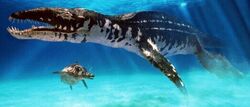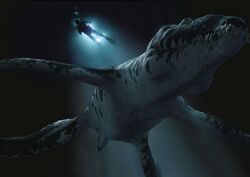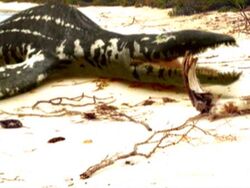Tag: sourceedit |
Tag: sourceedit |
||
| Line 68: | Line 68: | ||
**[[Cruel Sea]] |
**[[Cruel Sea]] |
||
*''[[Walking with Dinosaurs: A Natural History]]'' |
*''[[Walking with Dinosaurs: A Natural History]]'' |
||
| + | **[[A Cruel Sea]] |
||
*''[[Sea Monsters]]'' |
*''[[Sea Monsters]]'' |
||
**[[To Hell... and Back?]] |
**[[To Hell... and Back?]] |
||
*''[[Sea Monsters: Prehistoric Predators of the Deep]]'' |
*''[[Sea Monsters: Prehistoric Predators of the Deep]]'' |
||
*''[[Sea Monsters Adventure Game]]'' |
*''[[Sea Monsters Adventure Game]]'' |
||
| + | |||
===Notes and references=== |
===Notes and references=== |
||
{{reflist}} |
{{reflist}} |
||
Revision as of 00:43, 23 July 2015
| “ | ... at 150 tonnes, it is the largest and most powerful carnivore ever to live on the planet. | ” |
Liopleurodon was a species of large pliosaur from the late Jurassic period. It lived in the deep seas near the European coastlines, in vast territories.
With a maximum length of 25 metres, this creature was the largest carnivore to ever exist. Its incomprehensible size and strength made it indestructible to any attack.
Creature attributes
Physical appearance and biology
Liopleurodon was a very large pliosaur. It had the fundamental characteristics of the typical pliosaur, such as a large, heavy skull supported by a short neck. Its jaws carried a row of protruding, needle-sharp teeth. It also had powerful nostrils which were used to pinpoint the scent of its prey.
Each of Liopleurodon's four flippers was three meters in length. By alternately flapping its flippers, it managed to propel its huge bulk effortlessly through the Jurassic waters.
They were known to have most likely given live birth to their offspring.
The coloration of a Liopleurodon was very similar to that of a great white shark's. It had black scales on the top half of its body, probably to camouflage it from prey above it. Meanwhile, on the other half of its body, there were white scales that would camouflage it from prey below it.
Behavior and traits
Being the largest carnivore to have ever existed, Liopleurodon was the apex predator of every area it lived in. Liopleurodon had a variety of prey consisting of sharks, marine crocodiles, ichthyosaurs, other pliosaurs, and the largest fish that ever lived, Leedsichthys. Not even terrestrial prey such as Eustreptospondylus was safe from the large marine reptile. It would also occasionally scavenge carcasses. Because of its reputation, other predators would flee upon seeing Liopleurodon and would only attack individuals when they were wounded.
This species of pliosaur lived a more aquatic lifestyle than other plesiosaurs like Cryptoclidus due to its large size. Their size also made them territorial and they would fight for space. Adult Liopleurodon were constantly in danger of being beached if they got to close to the islands.
Juveniles lived in the shallows until the were old enough.
Classification and ancestry
The candidate for the ancestors of plesiosaurs are the nothosaurs of the Late Triassic. Liopleurodon in particular belongs to a group of plesiosaurs called pliosaurs that had short necks and large heads.
In Walking with Dinosaurs

An Ophthalmosaurus swiming under a Liopleurodon.
Liopleurodon appears in the series' intro at the 0:11 mark until 0:13.
Cruel Sea
A Liopleurodon comes out from the water and snatches an Eustreptospondylus off a rocky outcrop just before the title card of the episode is shown.
A male Liopleurodon later tears a female Ophthalmosaurus in half when she was having trouble giving birth. The male later encounters a female who he engages in a territorial dispute. The bull wins the fight by biting the female's left hind flipper and as she leaves her bleeding wound attracts Hybodus sharks that most likely kill her. The male Liopleurodon was one of the victims of the storm that occurred at the end of the episode. His cause of death was being beached and being consumed during his last moments of life by multiple scavenging Eustreptospondylus.
In Sea Monsters
Liopleurodon is one of the creatures listed on Nigel Marven's Time map.
To Hell... and Back?

Nigel with a Liopleurodon. (To Hell... and Back?)
Liopleurodon is the main hazard of the Jurassic seas and makes them the second deadliest sea of all time.
A Liopleurodon is attracted to the carcass of a Leedsichthys that Nigel witnessed die at the hands of a Metriorhynchus and a Hybodus earlier. He catches this large marine reptile on his radar and commands his shipmate Peter to bring out the Pole camera so he watch a video feed of the creature. Nigel gets a glimpse of the Liopleurodon, but it becomes frightened by the underwater camera. Amazed by what he saw, Nigel Marven decides he would live to go underwater with the reptiles.
Before he does this, him and his crew decide to test a suit capable of releasing a chemical that would detour Liopleurodon by using a mannequin filled with squid wearing the specialized suit on two young individuals. They first used shark repellant, but this fails to detour the hungry Liopleurodon. The crew then used the chemical Putrescine, which emits a foul smell, for their next experiment. The second experiment successfully drew away the pliosaurs with the closest to an aggressive action from them being a nudge. This greenlit Nigel Marven's dive with them.
During the night Nigel took a swim in the Jurassic seas, he witnessed a pair of two Liopleurodon feasting on the Leedsichthys carcass. Nigel Marven decided to get closer to frenzy, but one of the pliosaurs swam too close to Nigel causing him to release the Putrescine he had and to depart from the dangerous waters where he then proceeded to time travel to the Late Cretaceous.
Other appearances
Liopleurodon was one of the few creatures featured in the Walking with Dinosaurs pilot. Like in its appearance in Cruel Sea, the animal ended up beached on the shore.
Behind the scenes

A beached male Liopleurodon. (Cruel Sea)
No Liopleurodon specimen or any pliosaur ever was 25 meters in length nor did they weigh 90 tons. Estimates of real Liopleurodon say it was 6-7 meters in length with an estimated weight of less than 10 tons[1][2] and the largest pliosaur, Pliosaurus funkei, is estimated to have been only 10-12 meters long.[3][4] According to the ABC website and the now removed BBC website, what inspired the production team to make Liopleurodon over 20 meters was based off a skull fragment from the Natural History museum[5], but this estimate has been considered dubious at best.[6]
In The Complete Guide to Prehistoric Life, it is mentioned that Liopleurodon might have lived in Central America. The specimen they are referring to is "The Monster of Aramberri", a large pliosaur discovered in Mexico that some considered was a Liopleurodon ferox individual[7] though it is now thought to belong to another genus or its own.[8][9][10]
The design of Liopleurodon from Walking with Dinosaurs and Sea Monsters is very iconic with various toys and restorations of it and its relatives being based on the Walking with... series' Liopleurodon.
List of appearances
- Walking with Dinosaurs
- Walking with Dinosaurs: A Natural History
- A Cruel Sea
- Sea Monsters
- Sea Monsters: Prehistoric Predators of the Deep
- Sea Monsters Adventure Game
Notes and references
- ↑ About.com - Liopleurodon
- ↑ The Plesiosaur Site - Liopleurodon
- ↑ Wired - Paleontologists Reveal the Identity of "Predator X"
- ↑ Prehistoric Wildlife - Pliosaurus
- ↑ Walking with Dinosaurs - The Evidence
- ↑ Dinosaur Mailing List
- ↑ BBC News - Giant sea fossil unearthed
- ↑ Plesiosauria - Mine's Bigger Than Yours! The Monster of Aramberri, Predator X, and other monster pliosaurs in the media
- ↑ Dinosaur Mailing List
- ↑ The Plesiosaur Site - The 'Monster of Aramberri'
